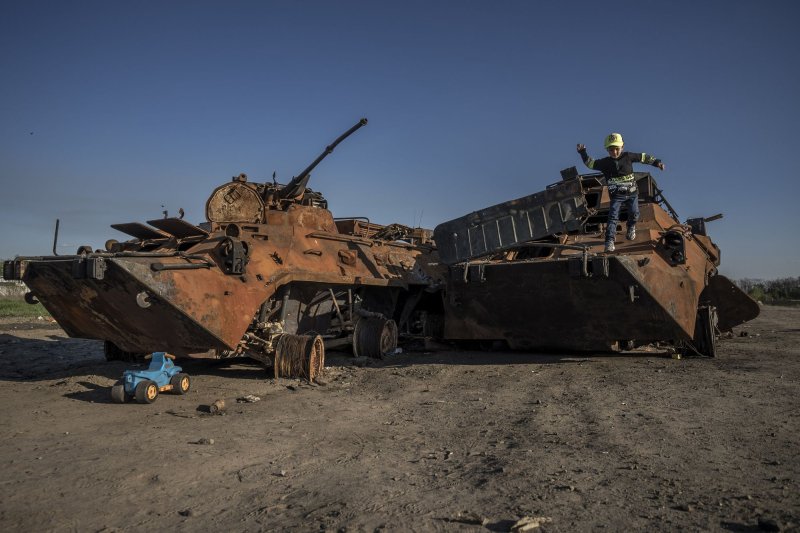A young boy plays on a burned out Russian tank near Irpin, Ukraine on Monday. Photo by Ken Cedeno/UPI |
License Photo
For 75 years, containment and deterrence were foundational for American and Western strategic thinking. But are both still relevant?
Neither Russia nor China has been contained from taking aggressive actions detrimental to the security and interests of many. While thermonuclear war has been deterred between the military superpowers, Russia surely was not deterred from invading Ukraine, the first major war in Europe since May 1945.
The history of containment and deterrence is well known. After the end of World War II, when an "iron curtain" descended over Eastern Europe, George Kennan's prescription of containment became strategic policy dominating Cold War policy. The concept of containment was to encircle the Union of Soviet Socialist Republics with a network of alliances to prevent further encroachment west. In 1949, the North Atlantic Treaty Organization was established as the major instrument for deterring and containing the Soviet Union.
Containment was extended to Asia and the Middle East. The Southeast Asia Treaty Organization came into force in 1955 and dissolved in 1977. Its purpose was to halt the spread of communism in Asia. The Vietnam War shattered that illusion.
The Middle East Treaty Organization, or Baghdad Pact, also known as CENTO, was formed in 1955 and dissolved in 1979. Its original members were the United Kingdom, Iran, Iraq, Pakistan and Turkey. It, too, failed to contain Soviet expansion with its foray into Egypt and the stationing of 25,000 Soviet troops.
Deterrence was based on the proposition that thermonuclear war was too destructive to be fought. Embraced by the Eisenhower administration's Strategic New Look, the strategy exploited American nuclear superiority over the Soviet Union. The theory was that these weapons, including for battlefield use, would deter Moscow from physical aggression against the United States and NATO. Over a number of administrations, the proposition was broadened to "extended deterrence" and the premise that nuclear deterrence could deter lesser conflict. That, too, turned out to be illusory.
After the Soviet Union imploded in 1991 and for the next decade and a half, U.S. foreign policy regarded the Russian Federation and China as potential partners who eventually would become more "Westernized" in internal and foreign policies. U.S. policy was supportive in keeping Russia from economically imploding and setting pro-Chinese trade policies. That thinking, likewise, would become an illusion.
Russia's seizure of South Ossetia and Abkhazia in 2008 was a critical inflection point and warning. Similarly, China's growing economic and military power could no longer be ignored by Washington. The arrival of the Obama administration in January 2009 would change American strategy. First was recognizing the growing influence of China through the badly implemented "pivot" to Asia in 2011, infuriating China and frightening allies.
In the second term, President Barack Obama's national security strategy was set on the 4+1 model. The United States had to deter, and if war came, defeat a series of potential adversaries topped by China and followed by Russia, North Korea, Iraq and then violent extremist organizations. How each was to be deterred and defeated was never specifically defined or translated in matching military power.
The Trump administration expanded "deter and defeat" to include "contain." As with the Obama 4+1 construct, none of those aims was well enough defined to determine the type and amount of military power necessary to achieve them. While the Biden National Security and Defense Strategies and Nuclear Posture Review were submitted to Congress along with the FY 2023 budget, none has been made public.
But Russia and China have not been contained or deterred. And how either could be defeated in a war that could become nuclear, likewise, is unknown. What does this mean for U.S. thinking?
A new strategic paradigm is needed to replace containment and deterrence with foundations relevant to today and not to the Cold War. My book, The Fifth Horseman and the New MAD: How Massive Attacks of Disruption Have Become the Looming Existential Danger for a Divided Nation and the World at Large, proposes one. Massive disruptions caused by man or nature are at least equal to or greater dangers than the traditional threats dominating national security thinking and must take higher priority. If COVID-19 were not sufficient warning, killing nearly a million Americans, Ukraine must be.
Instead of "contain, deter and defeat," the principal strategic aims must be to "protect, prevent, defend and, where appropriate, engage with friends and adversaries." Deterrence still applies to preventing general nuclear war. But it and containment as once defined are illusory. Unless this is recognized and a new, affordable paradigm created, U.S. national security will be at great risk. But is anyone taking note?
Harlan Ullman is senior adviser at Washington's Atlantic Council, the prime author of "shock and awe" and author of "The Fifth Horseman and the New MAD: How Massive Attacks of Disruption Became the Looming Existential Danger to a Divided Nation and the World at Large." Follow him @harlankullman.
The views and opinions expressed in this commentary are solely those of the author.















